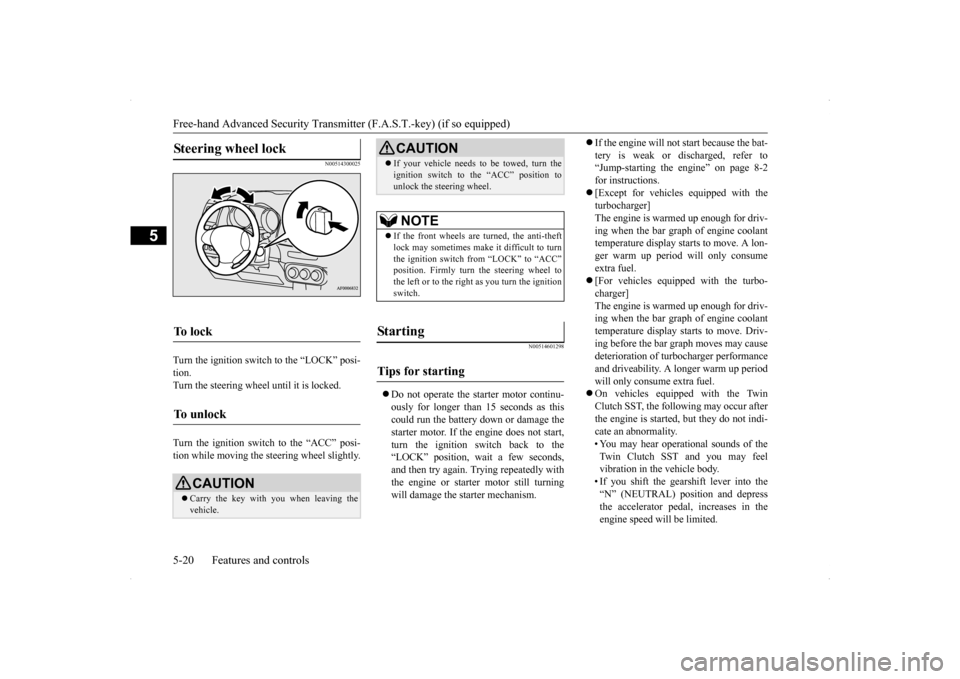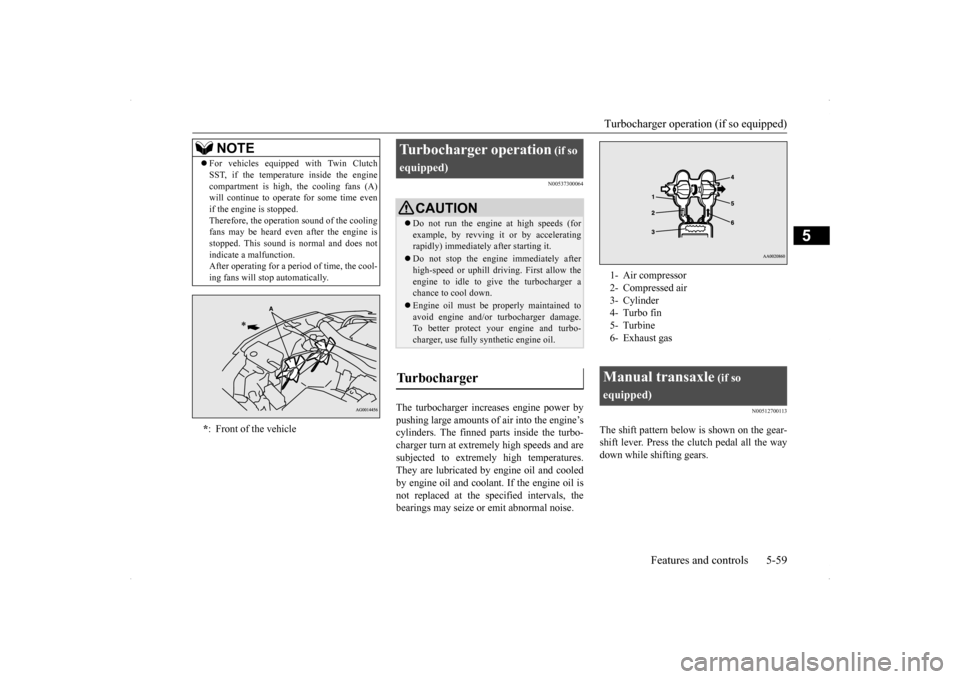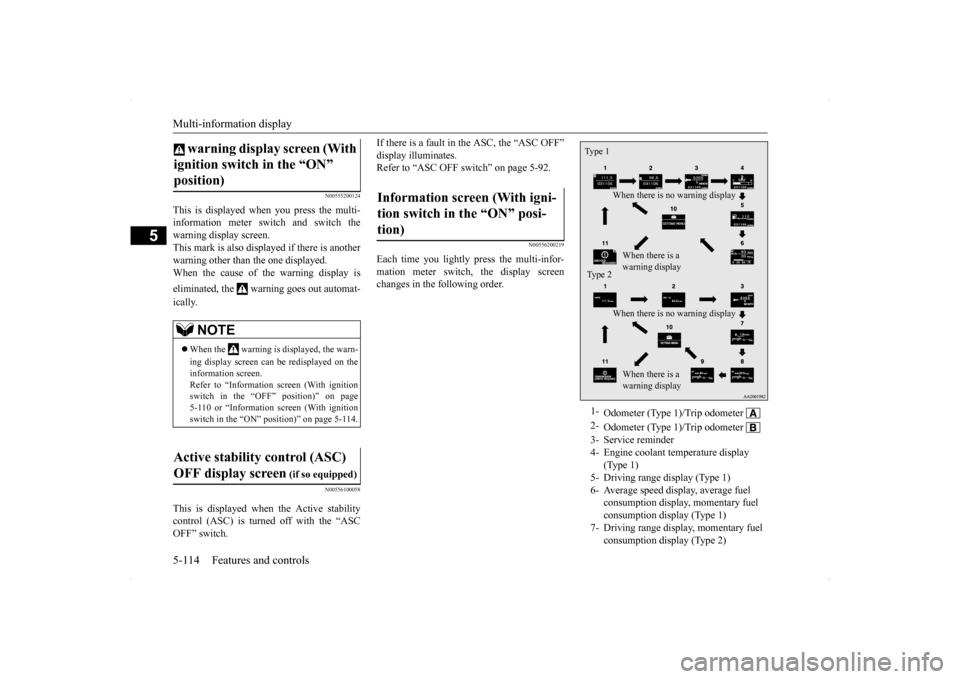2014 MITSUBISHI LANCER SPORTBACK coolant
[x] Cancel search: coolantPage 16 of 422

If this problem occurs...
Quick index 2-5
2
Problem
Do this
Ref. page
The engine coolant temperature display “ ” in the multi-infor- mation display is flashing. Steam comes out of the engine compartment. Type 1 Type 2
The engine is overheated. Carefully stop the vehicle in a safe place.
P.8-4
The vehicle is stuck in sand, mud, or snow.
Rock your vehicle back and forth to free it. P.8-15
WA R N I N G When attempting to rock your vehicle out of
a stuck position, be sure that no one is
near the vehicle. The rocking motion may c
ause the vehicle to
suddenly lurch forward or backward, possibly injuring bystanders. Avoid revving the engine or spinning the
wheels. Prolonged efforts to free a stuck ve
hicle may result in overheating and transa
xle failure.
If the vehicle remains stuck after several rocking at
tempts, have a towing service pull the vehicle out.
BK0200700US.bo
ok 5 ページ 2013年2月15日 金曜日 午後12時17分
Page 87 of 422

Free-hand Advanced Security Transmitter (F.A.S.T.-key) (if so equipped) 5-20 Features and controls
5
N00514300025
Turn the ignition switch to the “LOCK” posi- tion.Turn the steering wheel until it is locked. Turn the ignition switch to the “ACC” posi- tion while moving the steering wheel slightly.
N00514601298
Do not operate the starter motor continu- ously for longer than 15 seconds as thiscould run the battery down or damage the starter motor. If the engine does not start, turn the ignition switch back to the“LOCK” position, wait a few seconds, and then try again. Trying repeatedly with the engine or starter motor still turningwill damage the starter mechanism.
If the engine will not start because the bat- tery is weak or discharged, refer to “Jump-starting the engine” on page 8-2 for instructions. [Except for vehicles equipped with the turbocharger] The engine is warmed up enough for driv-ing when the bar graph of engine coolant temperature display starts to move. A lon- ger warm up period will only consumeextra fuel. [For vehicles equipped with the turbo- charger] The engine is warmed up enough for driv-ing when the bar graph of engine coolant temperature display starts to move. Driv- ing before the bar graph moves may causedeterioration of turbocharger performance and driveability. A longer warm up period will only consume extra fuel. On vehicles equipped with the Twin Clutch SST, the following may occur after the engine is started, but they do not indi-cate an abnormality. • You may hear operational sounds of the Twin Clutch SST and you may feelvibration in the vehicle body. • If you shift the gearshift lever into the “N” (NEUTRAL) position and depressthe accelerator pedal, increases in the engine speed will be limited.
Steering wheel lock
To l o c k
To u n l o c k
CAUTION Carry the key with you when leaving the vehicle.
If your vehicle needs to be towed, turn the ignition switch to the “ACC” position to unlock the steering wheel.NOTE
If the front wheels are turned, the anti-theft lock may sometimes make it difficult to turn the ignition switch from “LOCK” to “ACC”position. Firmly turn the steering wheel to the left or to the right as you turn the ignition switch.
St arting
Tips for starting
CAUTION
BK0200700US.bo
ok 20 ページ 2013年2月15日 金曜日 午後12時17分
Page 93 of 422
![MITSUBISHI LANCER SPORTBACK 2014 8.G Owners Manual Free-hand Advanced Security Transmitter (F.A.S.T.-key) (if so equipped) 5-26 Features and controls
5
[Except for vehicles equipped with the turbocharger] The engine is warmed up enough for driv- i MITSUBISHI LANCER SPORTBACK 2014 8.G Owners Manual Free-hand Advanced Security Transmitter (F.A.S.T.-key) (if so equipped) 5-26 Features and controls
5
[Except for vehicles equipped with the turbocharger] The engine is warmed up enough for driv- i](/manual-img/19/7508/w960_7508-92.png)
Free-hand Advanced Security Transmitter (F.A.S.T.-key) (if so equipped) 5-26 Features and controls
5
[Except for vehicles equipped with the turbocharger] The engine is warmed up enough for driv- ing when the bar graph of engine coolanttemperature display starts to move. A lon- ger warm up period will only consume extra fuel. [For vehicles equipped with the turbo- charger] The engine is warmed up enough for driv-ing when the bar graph of engine coolanttemperature display starts to move. Driv- ing before the bar graph moves may cause deterioration of turbocharger performanceand driveability. A longer warm up period will only consume extra fuel. On vehicles equipped with the Twin Clutch SST, the following may occur after the engine is started, but they do not indi- cate an abnormality.• You may hear operational sounds of the Twin Clutch SST and you may feel vibration in the vehicle body.• If you shift the gearshift lever into the “N” (NEUTRAL) position and depress the accelerator pedal, increases in theengine speed will be limited.
Starting the engine The vehicle is equipped with an electronically controlled fuel injection system. This is a sys-tem that automatically controls the fuel injec- tion. There is no need to depress the accelerator pedal when starting the engine.The starter motor should not be run for more than 15 seconds at a time. To prevent battery drain, wait a few secondsbetween attempts to restart the engine. 1. Make sure all occupants are properly seated with seat belts fastened. 2. Make sure the parking brake is applied.
3. While pushing the lock release buttons (A), remove the cover of the ignition switch. 4. Insert the emergency key into the ignition switch.
WA R N I N G Never run the engine in a closed or poorly ventilated area any longer than is needed to move your vehicle out of the area. Car- bon monoxide gas, which is odorless and extremely poisonous, could build up andcause serious injury or death.CAUTION Do not push-start the vehicle.Do not run the engine
at high rpms or drive
at high speeds until the engine has had a chance to warm up. Release the emergency key as soon as the engine starts. It will damage the startermotor.
BK0200700US.bo
ok 26 ページ 2013年2月15日 金曜日 午後12時17分
Page 123 of 422
![MITSUBISHI LANCER SPORTBACK 2014 8.G Owners Manual Starting and stopping the engine 5-56 Features and controls
5
[Except for vehicles equipped with the turbocharger] The engine is warmed up enough for driv- ing when the bar graph of engine coolant MITSUBISHI LANCER SPORTBACK 2014 8.G Owners Manual Starting and stopping the engine 5-56 Features and controls
5
[Except for vehicles equipped with the turbocharger] The engine is warmed up enough for driv- ing when the bar graph of engine coolant](/manual-img/19/7508/w960_7508-122.png)
Starting and stopping the engine 5-56 Features and controls
5
[Except for vehicles equipped with the turbocharger] The engine is warmed up enough for driv- ing when the bar graph of engine coolanttemperature display starts to move. A lon- ger warm up period will only consume extra fuel. [For vehicles equipped with the turbo- charger] The engine is warmed up enough for driv-ing when the bar graph of engine coolanttemperature display starts to move. Driv- ing before the bar graph moves may cause deterioration of turbocharger performanceand driveability. A longer warm up period will only consume extra fuel. On vehicles equipped with the Twin Clutch SST, the following may occur after the engine is started, but they do not indi- cate an abnormality.• You may hear operational sounds of the Twin Clutch SST and you may feel vibration in the vehicle body.• If you shift the gearshift lever into the “N” (NEUTRAL) position and depress the accelerator pedal, increases in theengine speed will be limited.
N00542200159
[For vehicles equipped with the F.A.S.T.-key]For information on operation for vehicles equipped with the F.A.S.T.-key, refer to “F.A.S.T.-key: Starting the engine” on page5-20. [Except for vehicles equipped with the F. A . S . T. - k e y ] Your vehicle is equipped with an electroni-cally controlled fuel injection system, which
automatically controls the release of fuel. There is usually no need to depress the accel- erator pedal when starting the engine. The starter should not be run for more than 15seconds at a time. To prevent battery drain, wait a few seconds between attempts to restart the engine. 1. Make sure all occupants are properly seated with seat belts fastened. 2. Insert the ignition key. 3. Make sure the parking brake is applied.4. Press and hold the brake pedal down withyour right foot. 5. Press and hold the clutch pedal all the way down (manual transaxle).
WA R N I N G Never run the engine in a closed or poorly ventilated area any longer than is needed to move your vehicle out of the area. Car- bon monoxide gas, which is odorless and extremely poisonous, could build up andcause serious injury or death.CAUTION Do not push-start the vehicle.Do not run the engine
at high rpms or drive
at high speeds until the engine has had a chance to warm up. Release the ignition switch as soon as the engine starts. Otherwise, the starter motorwill be damaged.
Starting the engine
NOTE
For models equipped with a manual trans- axle, the starter will
not operate unless the
clutch pedal is fully depressed (Clutch inter-lock). This is a safety feature.
BK0200700US.bo
ok 56 ページ 2013年2月15日 金曜日 午後12時17分
Page 126 of 422

Turbocharger operation (if so equipped)
Features and controls 5-59
5
N00537300064
The turbocharger increases engine power by pushing large amounts of air into the engine’s cylinders. The finned parts inside the turbo-charger turn at extremely high speeds and are subjected to extremely high temperatures. They are lubricated by engine oil and cooledby engine oil and coolant. If the engine oil is not replaced at the specified intervals, the bearings may seize or emit abnormal noise.
N00512700113
The shift pattern below is shown on the gear-shift lever. Press the clutch pedal all the waydown while shifting gears.
For vehicles equipped with Twin Clutch SST, if the temperature inside the engine compartment is high, the cooling fans (A) will continue to operate for some time even if the engine is stopped.Therefore, the operation sound of the cooling fans may be heard even after the engine is stopped. This sound is normal and does notindicate a malfunction. After operating for a period of time, the cool- ing fans will stop automatically.* : Front of the vehicleNOTE
Turbocharger operation
(if so
equipped)
CAUTION Do not run the engine at high speeds (for example, by revving it or by acceleratingrapidly) immediately after starting it. Do not stop the engine immediately after high-speed or uphill driv
ing. First allow the
engine to idle to give the turbocharger a chance to cool down. Engine oil must be properly maintained to avoid engine and/or turbocharger damage.To better protect your engine and turbo- charger, use fully synthetic engine oil.
Turbocharger
1- Air compressor 2- Compressed air3- Cylinder 4- Turbo fin 5- Turbine6- Exhaust gasManual transaxle
(if so
equipped)
BK0200700US.bo
ok 59 ページ 2013年2月15日 金曜日 午後12時17分
Page 175 of 422

Multi-information display 5-108 Features and controls
5
N00555000249
The multi-information display displays warn
ings, the odometer, trip odometer, service re
minder, engine coolant temperature, fue
l remaining, out-
side temperature, Twin Clutch SST control mode, ACD control
mode, gearshift lever position, selector lever position, average an
d momentary
fuel consumption, driving range, average speed, instrument brightness, etc. It is also possible to change elements such as th
e language and units used on the multi-information display.
Multi-information display
W i t h i g n i t i o n s w i t c h i s “ O N ” p o s i t i o n { C o nt i n u o us l y
v a r i a b l e t r a n s m i s s i o n ( C V T ) , Tw
i n C l u t c h S ST }
With ignition switch is “OFF” position
With ignition switch is “ON” position (Manual transaxle)
Type 1 Type 2 Type 1 Type 2 Type 1 Type 2
1-
Warning display screen (With igni- tion switch in the “OFF” position) P.5-109
2- Information screen (With ignition
switch in the “OFF” position) P.5-110 Interrupt display screen (With ignition switch in the “OFF” position) P.5-111
3- Door ajar warning display screen (With
ignition switch in the “OFF” position) P.5-112
4-
Warning display screen (With igni- tion switch in the “ON” position) P.5-114
5- Active stability control (ASC) OFF dis-
play screen (if so equipped)
P.5-114
6- Information screen (With ignition
switch in the “ON” position)
P. 5 - 1 1 4
Interrupt display screen (With ignition switch in the “ON” position)
P. 5 - 1 1 7
7- Outside temperature display screen
P.5-118
8- Fuel remaining display screen
P.5-119
BK0200700US.book
108 ページ 2013年2月15日 金曜日 午後12時17分
Page 176 of 422

Multi-information display
Features and controls 5-109
5
N00555100178
The multi-information meter switch is a but- ton marked “INFO” on the left side of thedash. Each time the multi-information meter switch is operated, a sound is emitted and the multi-information display changes between infor- mation such as warnings, service reminder, average and momentary fuel consumption,driving range, average speed and ACD con- trol mode display (if so equipped). It is also possible to change elements such asthe language and units used on the multi-
information display by operating the multi- information meter switch.
N00555200212
If you press the multi-information meter switch and return from the warning display screen to the previous screen, the warning is displayed. Refer to “Returning to the display screen from before the warning display” on page5-111. This mark is also displayed if there is another warning other than the one displayed. Whenthe cause of the warning display is elimi- nated, the warning goes out automatically.
9- Engine coolant temperature display (if
so equipped)
P.5-114
10- Twin Clutch SST control mode display
screen (Twin Clutch SST)
P. 5 - 7 6
11- Selector lever position display screen
(CVT)
P.5-64
Gearshift lever position display screen (Twin Clutch SST)
P. 5 - 7 2
12- ACD control mode display screen
(Twin Clutch SST)
P. 5 - 8 4
13- ECO mode indicator (if so equipped)
P. 5 - 1 1 9
14- Gearshift indicator display screen (if so
equipped)
P. 5 - 6 0
NOTE
The fuel units, temperature units, display language, and other settings can be changed.Refer to “Changing the function settings (With ignition switch in the “ON” position)” on page 5-121.
The display screen is different depending on whether the ignition switch in the “OFF” or “ON” position. Refer to “Information screen (With ignition switch in the “OFF” position)” on page5-110. Refer to “Warning displa
y list (With ignition
switch in the “OFF” position)” on page5-131. Refer to “Information screen (With ignition switch turned from “OFF” to “ON” posi-tion)” on page 5-113. Refer to “Information screen (With ignition switch in the “ON” position)” on page 5-114.Refer to “Warning displa
y list (With ignition
switch in the “ON” position)” on page 5-134.
Multi-information meter switch
NOTE
warning display screen (With ignition switch in the “OFF” position)
BK0200700US.book
109 ページ 2013年2月15日 金曜日 午後12時17分
Page 181 of 422

Multi-information display 5-114 Features and controls
5
N00555200124
This is displayed when you press the multi- information meter switch and switch the warning display screen.This mark is also displayed if there is another warning other than the one displayed. When the cause of the warning display is eliminated, the warning goes out automat- ically.
N00556100058
This is displayed when the Active stability control (ASC) is turned off with the “ASCOFF” switch.
If there is a fault in the ASC, the “ASC OFF” display illuminates. Refer to “ASC OFF switch” on page 5-92.
N00556200219
Each time you lightly press the multi-infor- mation meter switch, the display screenchanges in the following order.
warning display screen (With ignition switch in the “ON” position)
NOTE
When the warning is displayed, the warn- ing display screen can be redisplayed on the information screen. Refer to “Information screen (With ignition switch in the “OFF” position)” on page5-110 or “Information screen (With ignition switch in the “ON” position)” on page 5-114.
Active stability control (ASC) OFF display screen
(if so equipped)
Information screen (With igni-tion switch in the “ON” posi-tion)
1-
Odometer (Type 1)/Trip odometer
2-
Odometer (Type 1)/Trip odometer
3- Service reminder4- Engine coolant temperature display
(Type 1)
5- Driving range display (Type 1)6- Average speed display, average fuel
consumption display, momentary fuel consumption display (Type 1)
7- Driving range display, momentary fuel
consumption display (Type 2)
Type 1
When there is no warning display When there is a warning display
Type 2
When there is no warning display When there is a warning display
BK0200700US.book
114 ページ 2013年2月15日 金曜日 午後12時17分